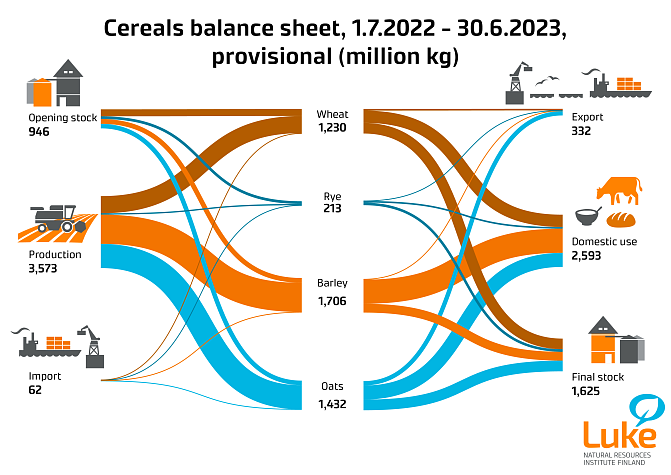Finland’s cereal production forms the basis of domestic food – as cereal, dairy and meat products
Barley, oats, wheat and rye come in this order when the cereal harvest is weighed during the autumn harvest season. The same order stands when different types of cereals are measured as livestock feed. On our plates, wheat plays the largest and barley the smallest role. In our drinking glasses, barley takes a clear lead after malting barley has done its duty.
Cereal production volumes are partly dictated by natural forces
The total production area of different cereals has not changed dramatically during the last decades. In contrast, the harvest levels produced in our cereal area of almost a million hectares have fluctuated in recent years – upwards rather than downwards. The cereal harvest has ranged from 2.6 to 4.2 million tons in the 2000s.
Each year, 2.6–2.8 million tons of cereals are consumed in Finland. Barley accounts for nearly half of this volume, while the rest is covered almost completely by wheat and oats. The rye volume required to meet our demand for rye bread only accounts for a small fraction, roughly a thirtieth of our total cereal consumption.

Use as feed decreasing
In Finland, the annual consumption of cereals as feed is estimated at 1.6–2.0 million tons. Of the 2022 cereal harvest of roughly 3.6 million tons, it is estimated that 1.6 million tons were used as feed. Farms partly use cereals to feed their pigs, cows, chicken and other livestock. Barley is the most significant fodder cereal, accounting for roughly half of the total use of cereals as feed, followed by oats slightly ahead of wheat.
Even though the volumes of fodder cereals are difficult to estimate accurately, their use is showing clear signs of a downward trend. Only 15 years ago, the use of cereals as feed totalled roughly 500,000 tons more than at present.
The food industry uses more oats than before
The Finnish food industry consumes 410,000–470,000 tons of cereals annually. During the last decade, the consumption of oats has passed rye. However, wheat plays the most significant role in industrial food production, accounting for roughly half of total consumption.
Domestic cereals are consumed almost entirely in Finland
Only a significant part of oats is exported. The annual export volume of oats is roughly 300,000 tons. While cereals are also imported into Finland, the volumes are only significant during poor harvest years. In 2021, harvest levels were exceptionally low, and more than 100,000 tons of barley were imported.

Slow changes in uses of cereals
The total consumption of cereals has decreased slightly in recent years. This can partly be explained by a few poor harvest years, during which replacements for barley in particular had to be sought in cattle feeding. However, the largest reason is the continued decrease in the number of cattle and pigs in Finland. A smaller volume of cereals has therefore been used in livestock feeding.
Background to the statistics
Luke’s Statistical Services monitors the production, use, consumption and stocks of domestic cereals on the basis of available statistical data. The cereal balance sheet and statistics on the use of harvests on farms are prepared every harvest year. The most recent statistics are estimates prepared for the harvest year from 1 July 2022 to 30 June 2023. The statistics are available on Luke’s website at luke.fi/en. The Finnish Cereal Committee also monitors the status of the current harvest year (1 July 2023 – 30 June 2024) on a quarterly basis on its website. On 22 September, Luke will publish harvest estimate statistics, representing the harvest outlook for Finnish fields as of 18 September 2023.
Statistical publications
- Cereals balance sheet, 2022- 2023 (provisional) and 2021 - 2022 final figures
- Use of Crops on Farms 2022–2023 (provisional) and 2021-2022 (final statistics)
- Statistic on the purchase, use and storage of cereals and protein and oilseeds
- Crop Production Statistics
- Utilised Agricultural Area
- Number of Livestock
- Balance Sheet for Food Commodities




